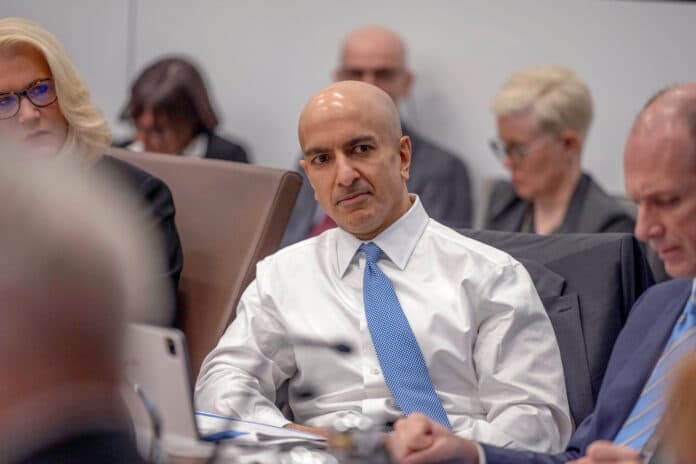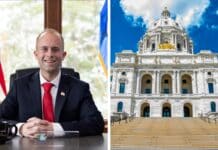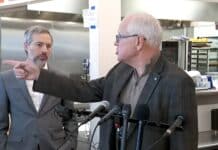
Minneapolis Federal Reserve Bank President Neel Kashkari said Tuesday that policymakers at the U.S. central bank should wait for “many more months” of data showing inflation is trending down before lowering interest rates, while expressly not ruling out even more rate hikes if price pressures once again build steam.
Mr. Kashkari’s remarks, made during an interview with CNBC and at a Barclay’s event in London on May 28, are significant given Mr. Kashkari’s reputation for leaning dovish, meaning tending to advocate for looser monetary policy settings, or lower rates.
The Minneapolis Fed chief’s remarks suggest that market expectations for the central bank to lower interest rates at some point in 2024 may end up dashed on the rocks of persistently high inflation — especially in light of recent economic data pointing to price pressures rising again. For instance, data released on May 28 by The Conference Board indicates that 12-month inflation expectations among U.S. consumers have increased to 5.4 percent, which is nearly three times higher than the Fed’s 2 percent target.
“Many more months of positive inflation data, I think, to give me confidence that it’s appropriate to dial back,” Mr. Kashkari said in the CNBC interview, when asked what kind of conditions would need to be in place for the Fed to deliver one or two rate cuts by the end of this year.
Markets are pricing in a single 0.25 percentage-point rate cut this year (down from the current 5.25–5.5 percent) at the Fed’s policy meeting of the Federal Open Market Committee (FOMC) on Nov. 7, 2024, according to the CME Fed Watch Tool, which is a measure of investor expectations based on futures contracts. A second 25 basis-point rate cut is expected by the FOMC’s meeting on Jan. 29, 2025.
But Mr. Kashkari’s remarks make clear those odds could shift to a higher-for-longer scenario if inflation remains elevated, with all eyes now on the Fed’s preferred inflation gauge, the Personal Consumption Expenditures (PCE) price index, which showed the pace of inflation accelerating to 2.7 percent in March from 2.5 percent in February, according to the latest available data. April’s PCE numbers come out on May 31, with investors expecting another 2.7 percent reading — meaning one that would reflect price pressures stuck in high gear, nearly a full percentage point above the Fed’s target.
More rate hikes?
During the Barclay’s event in London, Mr. Kashkari said he’s been asked many times when members of the Federal Open Market Committee would take potential interest-rate hikes off the table.
“I don’t think anybody has formally taken them off the table,” he said. “Even me, I say that we could sit here for as long as necessary, until we get convinced that inflation is sustainably going back down to our 2 percent target.”
Mr. Kashkari added that, while he thinks the most likely scenario is higher for longer, he’s not dismissing the possibility of more hikes.
“I’m not ruling out potential interest-rate increases from here, but I think sitting where we are for an extended period of time is a more likely outcome,” he said. “But of course, if we get surprised by the data, then we would do what we need to do … for the committee to get inflation all the way back down to our 2 percent.
“There’s no deviation around the table,” he continued, referring to FOMC members’ views about being willing to hike rates if higher inflation strikes again. “The only deviation is our outlooks as to what’s happening with the underlying inflationary dynamics.”
The Minneapolis Fed chief’s remarks are the latest from a Fed official on the topic of interest rates and inflation, which come as market expectations for the fed funds level have see-sawed this year in line with inflation data, which have been up and down.
The possibility that the Fed could kick off interest-rate cuts this year has sent Wall Street on a record-breaking rally since late 2023, with the Nasdaq and S&P 500 Index hitting all-time highs last week.
“Higher for longer with rates, as it has been with inflation, means that borrowing costs will stay elevated,” Bankrate senior economic analyst Mark Hamrick told The Epoch Times in an emailed statement.
Higher borrowing costs would have a cooling effect on the economy, with the latest Conference Board data indicating that consumers’ assessment of their financial situation both currently and over the next six months have deteriorated slightly. Not only that but the perceived likelihood of a recession over the next 12 months rose in May among consumers, although they remained upbeat about the stock market, with 48.2 percent expecting stocks to go up in the year ahead, compared to 25.4 percent who expect a drop and 26.4 percent expecting no change.
High interest rates have also put home ownership out of reach for many Americans, especially first-time homebuyers. Prospective homebuyers need to earn nearly twice as much to afford a typical home today as they did around four years ago, according to a recent study by Redfin.
Death of the ‘American Dream’
As inflation has remained persistently elevated, former President Donald Trump recently redoubled his focus on criticizing policies that he says are responsible for high prices on President Joe Biden’s watch.
During a keynote speech at the Minnesota Republican Party’s annual Lincoln Reagan Dinner in St. Paul, the former president lamented “Bidenomics” and joked he no longer eats bacon because it’s become so expensive.
Later, in a post on Truth Social, his social media platform, the ex-president claimed that the price hikes since his rival assumed office are costing the typical Minnesota family an additional $1,165 each month compared to the Trump presidency.
“When I left office, we had NO INFLATION,” President Trump said in a post on Truth Social. “Yet in the past 3 years, the Biden Inflation Tax has cost the average Minnesota family a staggering $28,000 — and the Biden Price Hikes are continuing to drain $1,165 from the typical Minnesota family budget every single month!”
While President Trump didn’t explain the source of the $1,165 figure for extra costs due to rising prices under the Biden administration, the American Institute for Economic Research’s cost-of-living calculator shows that this number nationwide is roughly the same.
Prices have risen 19.9 percent since President Biden took office, according to the latest inflation data from the government’s Consumer Price Index (CPI) report. In some categories, the pace of inflation is even higher. For example, rent is up 20.8 percent, grocery prices are up 21.3 percent, and car repairs are up 30.2 percent.
This article was originally published at The Epoch Times.









